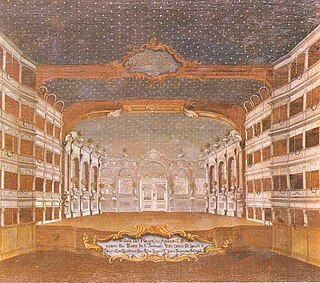
Domenico Cimarosa was an Italian composer of the Neapolitan School and of the Classical period. He wrote more than eighty operas, the best known of which is Il matrimonio segreto (1792); most of his operas are comedies. He also wrote instrumental works and church music.

Pietro Alessandro Guglielmi was an Italian opera composer of the classical period.
A catalogue aria is a genre of opera aria in which the singer recounts a list of information that was popular in Italian comic opera in the latter half of the eighteenth and early nineteenth centuries.

Il maestro di cappella is an operatic intermezzo in one act by Domenico Cimarosa. The first known performance of the work was on 2 July 1793 in Berlin, Germany. However, it is likely that this was not the premier production, and music historians believe the opera debuted some time between 1786 and 1792. The author of the opera's libretto is now unknown.

La Cleopatra (1789) is an opera seria in two acts by composer Domenico Cimarosa with an Italian libretto by Ferdinando Moretti.

Le astuzie femminili is a dramma giocoso in four acts by Domenico Cimarosa with an Italian libretto by Giuseppe Palomba. The opera buffa premiered at the Teatro dei Fiorentini in Naples, Italy, on 26 August 1794. The opera was subsequently performed in Barcelona in 1795, Lisbon in 1797, Vienna in 1799, Paris in 1802, and London in 1804, remaining popular during the first quarter of the nineteenth century. Although not performed often today, the opera is still occasionally revived and a number of recordings have been made.

La finta parigina (The false Parisienne) is an opera buffa in 3 acts by Domenico Cimarosa with an Italian libretto by Francesco Cerlone. The opera premiered at the Teatro Nuovo in Naples, in 1773.

Le donne rivali is an intermezzo in two acts by composer Domenico Cimarosa with an Italian libretto by a now unknown poet. It is speculated that Giuseppe Petrosellini may have been the author of the libretto. The opera premiered at the Teatro Valle in Rome during Carnival in 1780. The original choreography was created by Alberto Cavos, the original costumes by Antonio Dian, and the original scenery by Domenico Fossati. In accordance with Papal law on theatre in Rome, the premiere cast was all-male.

Gli Orazi e i Curiazi is an opera in three acts composed by Domenico Cimarosa to a libretto by Antonio Simeone Sografi, based on Pierre Corneille's tragedy Horace.

Teatro San Samuele was an opera house and theatre located at the Rio del Duca, between Campo San Samuele and Campo Santo Stefano, in Venice. One of several important theatres built in that city by the Grimani family, the theatre opened in 1656 and operated continuously until a fire destroyed the theatre in 1747. A new structure was built and opened in 1748, but financial difficulties forced the theatre to close and be sold in 1770. The theatre remained active until 1807 when it was shut down by Napoleonic decree. It reopened in 1815 and was later acquired by impresario Giuseppe Camploy in 1819. In 1853 the theatre was renamed the Teatro Camploy. Upon Camploy's death in 1889, the theatre was bequeathed to the City of Verona. The Venice City Council in turn bought the theatre and demolished it in 1894.

L'Italiana in Londra is one of eight comic operas, termed intermezzi, which Domenico Cimarosa wrote between 1777 and 1784 for the Teatro Valle, a handsome neo-classical Roman theatre built in 1726, which still stands today.
Le stravaganze del conte is the first opera by Italian composer Domenico Cimarosa. The comic opera was first performed at the Teatro de' Fiorentini at Naples in 1772.
Giuseppe Petrosellini was an Italian poet and prolific librettist working primarily in the dramma giocoso and opera buffa genres.

Il ritorno di Don Calandrino, also known as Armidoro e Laurina, is an intermezzo in two acts by Domenico Cimarosa to an Italian libretto presumably written by Giuseppe Petrosellini.
Sinfonia in B-flat major for 2 oboes, 2 horns and strings is one of several instrumental works by Domenico Cimarosa. The parts for this particular Sinfonia are located in the Zentralbibliothek in Solothurn, Switzerland. The instrumentation of this work was written perfectly for the orchestras in Naples which maintained two oboes, two trumpets, and strings.

The Teatro Nuovo is a theatre located on Via Montecalvario in the Quartieri Spagnoli district of Naples. The original theatre was an opera house designed by Domenico Antonio Vaccaro. Completed in 1724, it was also known as the Teatro Nuovo sopra Toledo and the Teatro Nuovo de Montecalvario. The theatre specialised in the opera buffa genre and saw the world premieres of hundreds of operas in its heyday. These included fifteen of Cimarosa's operas and seven of Donizetti's. The present theatre is the third to have been erected on the site following its destruction by fire in 1861 and again in 1935.
Artemisia is the last opera of Domenico Cimarosa. The libretto, in three acts, is by Count Giovanni Battista Colloredo. Cimarosa died on 11 January 1801 before writing the music to Act III; the first performance, given at the Teatro La Fenice in Venice on 17 January 1801, also included interpolations by other hands in the first two acts.
Angelo Maria Benincori was an Italian composer. He wrote string quartets and, in Paris, endeavoured to be a successful composer of operas; his greatest success, the performance of his completion of Nicolas Isouard's opera Aladin, came a few weeks after his death.








